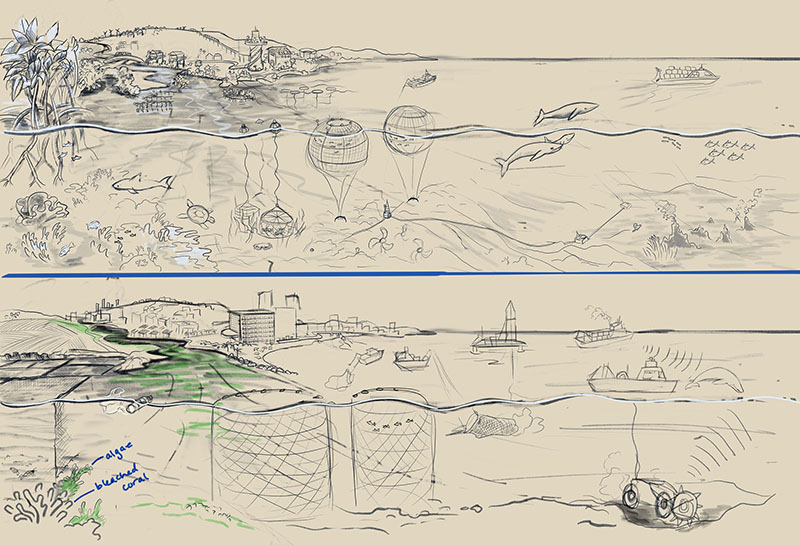
The Future of Our Oceans Science Illustration
Picture our oceans in 30 years. What do you see? The year 2050 isn’t that far off, and it’s critically important that we make changes now to secure a healthy future. The lead image above paints a dark picture of future ocean ecosystems—but it doesn’t have to turn out this way.
Ecologist, marine biologist, and conservationist Douglas J. McCauley, UCSB, contacted Nicolle to create this ocean ecology science illustration. For McCauley’s article, 10 steps to save the ocean, he needed a vivid visual of the consequences of inaction. Read on to learn more about the process of creating this epic illustration, and to see the alternative, healthy future (or jump to the full art close-up).

This is the kind of challenge we love at SayoStudio—making epic, conceptually complex art pieces for important causes. Nicolle has had the pleasure of working with the McCauley lab for many years, with one of our first and most popular collaborations shown here, comparing land and ocean extinctions. McCauley referenced this land vs sea extinction art as a starting point for his vision of the new ecology landscape. (Here’s another of our favorite ecology illustrations, focused on hippo poop!).
The land/sea extinction comparison was one of SayoStudio’s first ‘epic’ pieces. It shows the history of the human impact on land and the parallels to our oceans’ possible ecological future. This piece became a great example of how rich and visually complex an infographic can be.
Clarifying Details: Research and Sketching Ocean Ecology Science Illustration
McCauley provided Nicolle with a detailed list of content to include, plus pages of helpful photo references. The healthy ocean ecology illustration needed to include:
- sustainable fishing
- green energy, including solar, wind, and wave
- sustainable farming, including landbased and aquaculture
- people’s role, enjoying recreation, and clean cities and communities
- responsible shipping powered by green energy
- diverse marine life, from mangroves and corals to deep-sea vents
versus the unhealthy vision, where the ocean ecosystem has collapsed:
- destructive trawling fishing leaving little behind
- oil drilling, polluting the ocean and air
- large-scale pollution from land-based farming and aquaculture
- unsustainable land-use; unhealthy housing
- polluting cargo ships that interfere with whales and other marine animal communication
- little sea life left, replaced with plastic pollution
Composing the Ocean Ecology Science Illustration
 Starting with McCauley’s references, Nicolle gathered her own research to envision what a healthy, sustainable landscape might look like in 30 years. Since we were visualizing a tropical ocean, Singapore’s amazing, futuristic architecture served as great inspiration.
Starting with McCauley’s references, Nicolle gathered her own research to envision what a healthy, sustainable landscape might look like in 30 years. Since we were visualizing a tropical ocean, Singapore’s amazing, futuristic architecture served as great inspiration.
Sadly, envisioning the unhealthy alternative isn’t as hard, as there are already many photographic examples from across the world.
To confirm that our visions matched, Nicolle followed her typical process with a pencil sketch for review. The details of the sketch are a bit rougher than usual. Since we’d worked together so many times before, we had an ample range of work to reference, and McCauley felt confident about the final art’s quality. Mostly we needed to confirm the overall composition and make sure there weren’t missing key elements. He and his lab gave some suggestions on the sketch to incorporate into the color art creation: for example, they emphasized the need to represent people in the healthy view.
Color Art, Bringing the Ocean Art to Life
With the composition agreed on, Nicolle started 3D-modeling the landscape. First, she focused on the background hills and underlying ocean bottom. This was created in the terrain software Gaea, which uses erosion algorithms to create realistic landscapes. We wanted to have the option to create a simple animated version, fading from one view to the other. To do so, the ‘bones’ of the 2 landscapes needed to match as closely as possible.

When representing ecological systems, Nicolle often begins with the overall sky. It helps set the tone and motivates her to fill the scene. From the start, we knew we wanted a sky free of pollution for the healthy view, and a darker, polluted sky for the unhealthy scene. With the overall landscape taking shape, Nicolle started modeling individual components.
When working in 3D it’s possible to buy pre-made models to place in a scene. Although SayoStudio does use stock models on occasion, we often hand-model to create our own unique pieces that better fit the science. Custom models in this creation include much of the coral, the futuristic city, the futuristic fishing boat and cargo boat, the yellow Argos floats, and the fishing nets. For the people, models were customized from Daz 3D. For other parts, like the complex cargo ships, it made more sense to use stock models, such as the complex cargo ships in the unhealthy scene. Still other pieces start with a model with details hand-drawn on top.
Final Touches to the Ocean Ecology Illustration

Like many digital illustrators, we remind ourselves from time to time that we were trained to draw traditionally. It was more efficient to hand-draw the fish and other animals. As each piece was finished, whether with a 3D model or a hand drawing, Nicolle added it to the larger landscape in Photoshop. This collage approach allows for more flexibility. Although compositions can’t be fully changed in the color art stage, collaging makes it easier to add or subtract elements.
With most of the pieces in place, the final task was to emphasize the contrast between the scenes. Nicolle has trained herself to make uncomfortable subjects palatable, so it was challenging to make the unhealthy vision dark and foreboding. McCauley did a fantastic job art-directing and suggested ways to really make the contrast clear. Nicolle shifted the polluted landscapes’ colors toward more browns and exaggerated the saturation of blues in the healthy version. You may also notice other details, like more garbage, in later iterations of the polluted scene. In the healthy future, Nicolle “planted” kelp in the background and played with the balance of colorful fish to keep the eye moving through the image.

The Final Ocean Ecology Science Illustration
There are so many details in this illustration that Nicolle created an animated view to zoom in for a closer look. The article used the final still art, but the animated version proved useful to promote the story across social media. To learn more about the science, and what you can do to impact change, see McCauley’s article at the World Economic Forum.
